FK Rostov has a 90-year history, but they are not a dominant force in the Russian Premier League. They have not won the title since 1992, but have managed to recently become a contender for the European slots, making their debut in the UEFA Champions League in the same group as Bayern Munich and Atlético Madrid in 2016/17.
Since 2017, the former Real Sociedad player, Valeri Karpin has been the manager of this emerging force in Russian football. The club also tweaked their transfer policy, recruiting young talented prospects from Scandinavian football, such as Dennis Hadžikadunić, Armin Gigović, Pontus Almqvist and Mathias Normann. They have played some interesting football this season, and are looking for a way back into Europe again.
This tactical analysis introduces Karpin’s philosophy, especially through some key tactical concepts that his Rostov side have been showing on the pitch every week.
Vertical build-up
Offensively, Karpin’s core principle is to build-up vertically; his players are encouraged to break the lines to find teammates behind the opposition midfield or defence. This is the quickest way to advance the ball, and the likes of Hadžikadunić and Normann are good at passing and executing these tactics.
Rostov have also put structures and movements in place to help carry out these tactics, which will be explained in this section.
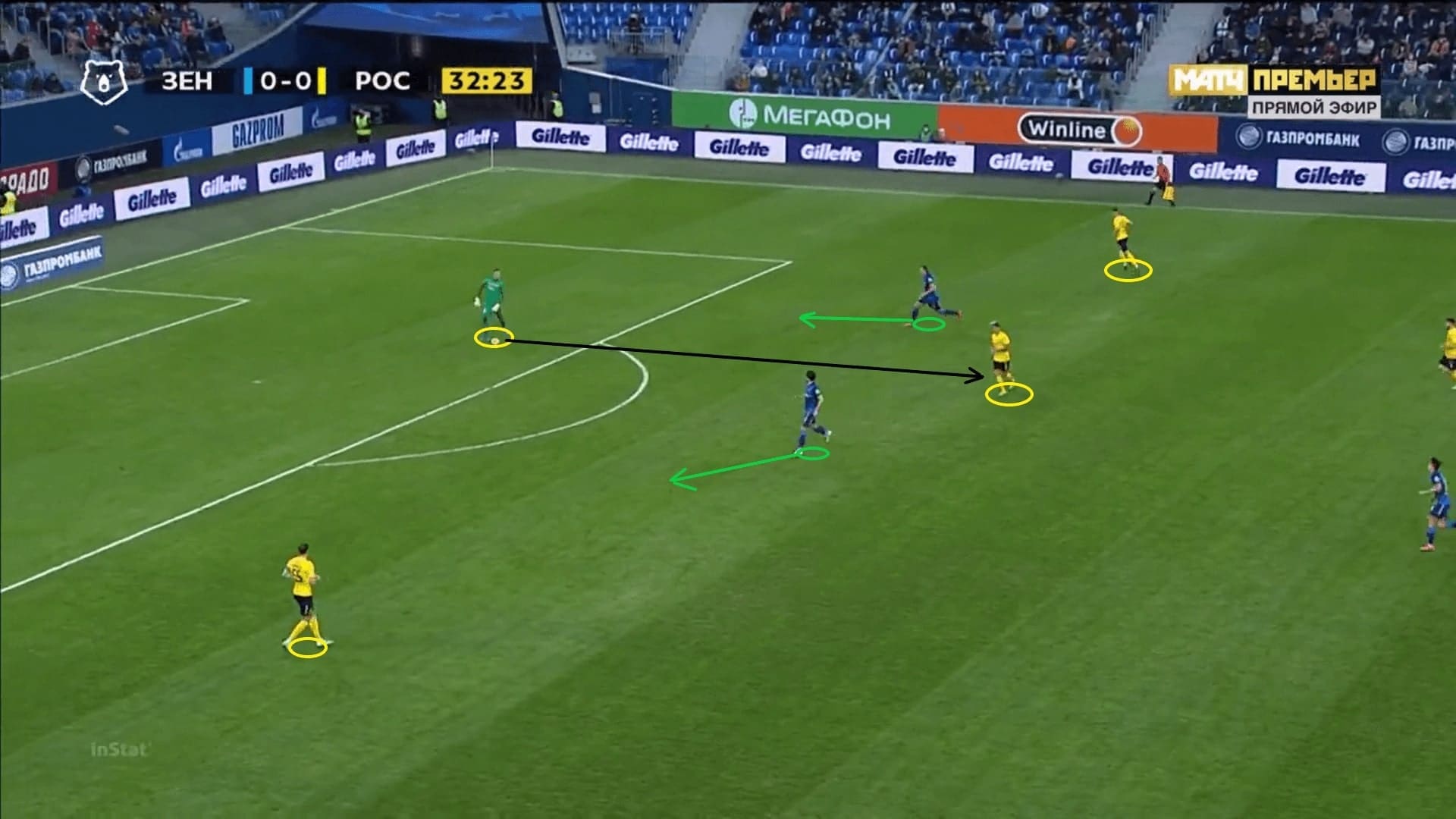
Against teams that press high with two strikers, Karpin’s prefers his team to stay in a back three by dropping the midfield pivot into the first line. The goalkeeper should also possess reasonable kicking ability to be a part of the build-up. The players need to open the pitch through their positioning to stretch the two strikers, and also to maximize the space they can exploit.
The first image here shows Normann, the midfielder dropping between the centre-backs. The team is now in a back three shape, and also has a 4v2 numerical superiority at the back. When the opposition strikers were instructed to defend the centre-backs, the duo split wider, and the central passing lane was opened up. Hence, Normann became the free option to receive the ball from the keeper.
Even though the right-sided centre-back was seemingly the easier option, the example shows how a vertical pass to break the lines was the priority.
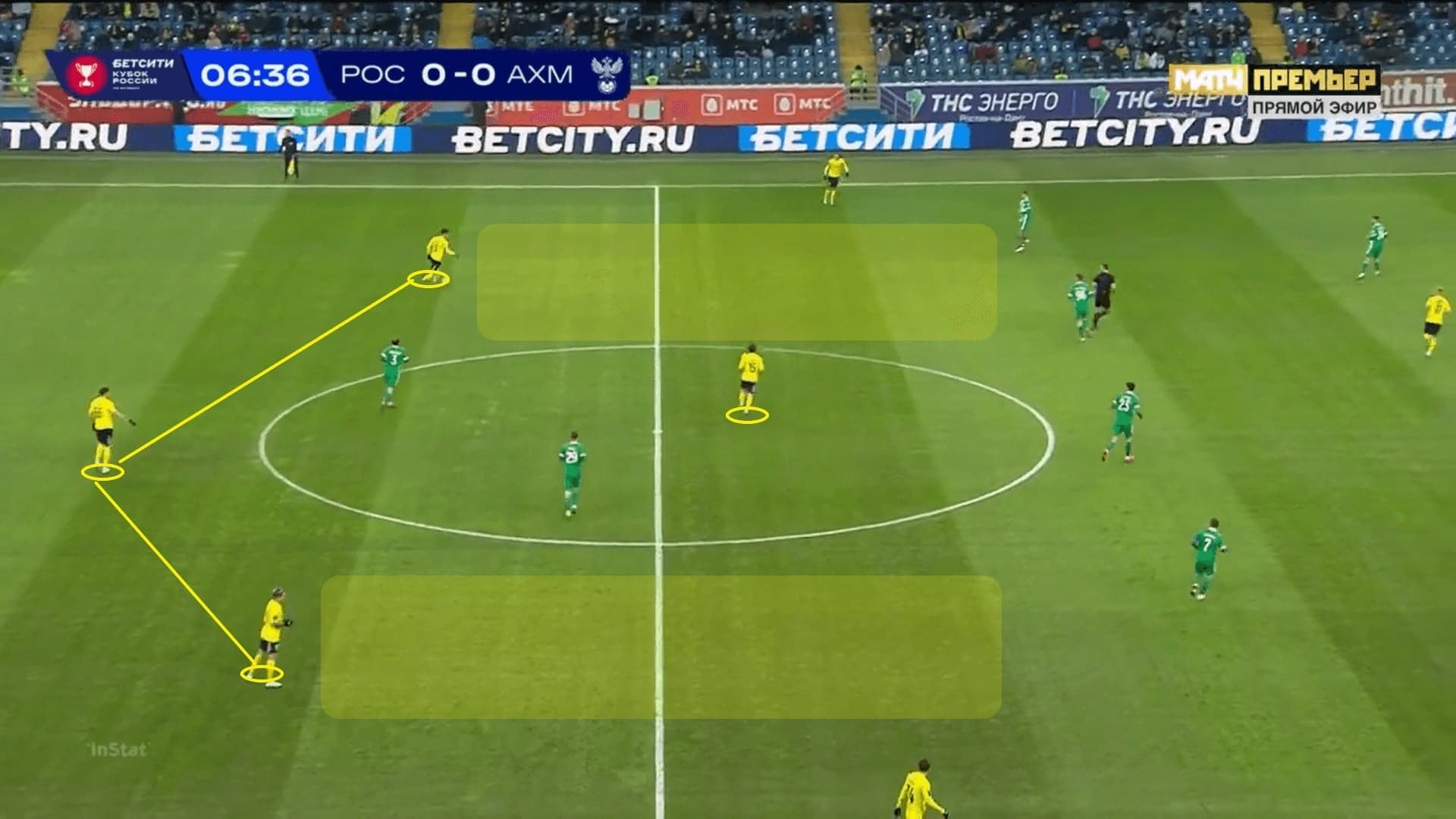
Against a 4-4-2 midblock, similar concepts are applied to advance the ball into higher areas. By creating a back three, Rostov inevitably occupied more vertical channels than in the first line of the defence. They use the free player to bring the ball forward in the free channel.
The image shows the back three, but Normann is not between the centre-backs. Instead, he was in the right half-space. This was the flexibility of Rostov’s build-up, where the players are able to understand the game and create the shape needed in the most effective way; they did not dogmatically stick to positions that could be sub-optimal.
The space in the half-spaces are illustrated in yellow here. Since the central centre-back and pivot absorbed pressure inside, both half-spaces were open to be exploited. The left centre-back could carry the ball upfield to face the opposition’s second line, searching for a line-breaking pass.
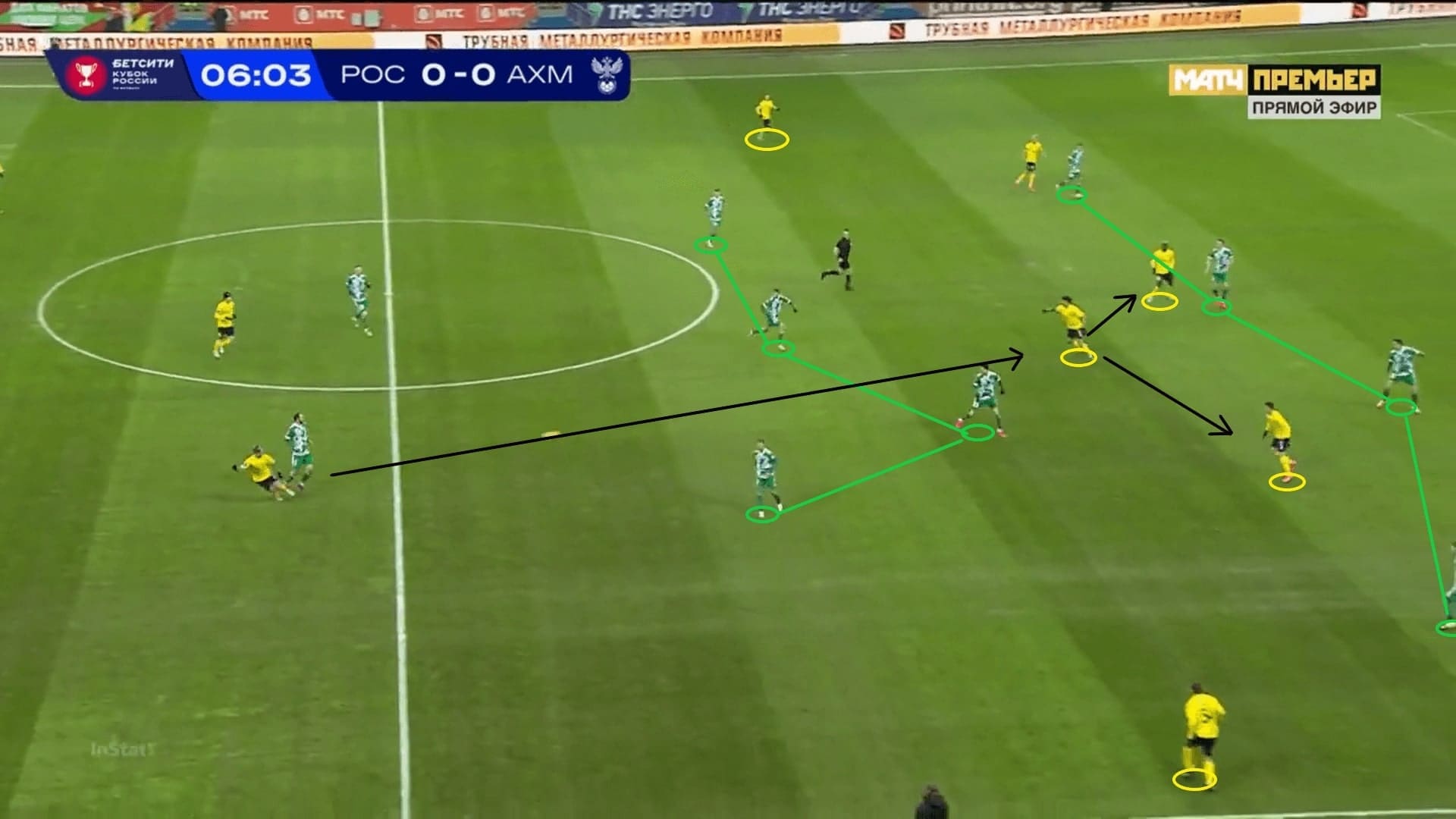
Meanwhile, the biggest restriction to vertical build-up is if the ball receivers have closed body orientations, which limits their visual information and perception, and therefore reduces the possible angles for playing passes. The team needs to create a structure to increase the interplay between players, otherwise it is easy to lose the ball when pressure comes from the blind side.
Therefore, Karpin wants his wingers to move infield and stay close to the striker. The front three need to position themselves behind the midfield, so that passes can break the line(s), while also giving them some space and time to develop the attack further. This next image will provide an idea of Rostov’s positional structure when advancing from the second phase to the offensive third.
First, the centre-back passed to the midfielder, Roman Eremenko’s feet – this is an example of the verticality and line-breaking that we have mentioned earlier. It is vital to move behind the lines here; if the former Celtic player dropped outside of the block, there would be no progression. Meanwhile, you can see the winger, Dimitri Poloz staying narrow in the centre with Ali Sowe, the striker. These players between the lines were in close proximity to each other to enable quick combinations between them.
To try opening as many vertical channels as possible, the full-backs stay very wide to take advantage of the narrow wingers. They overlap and join the attack by providing crosses, which we will dive see in more detail in the next image.
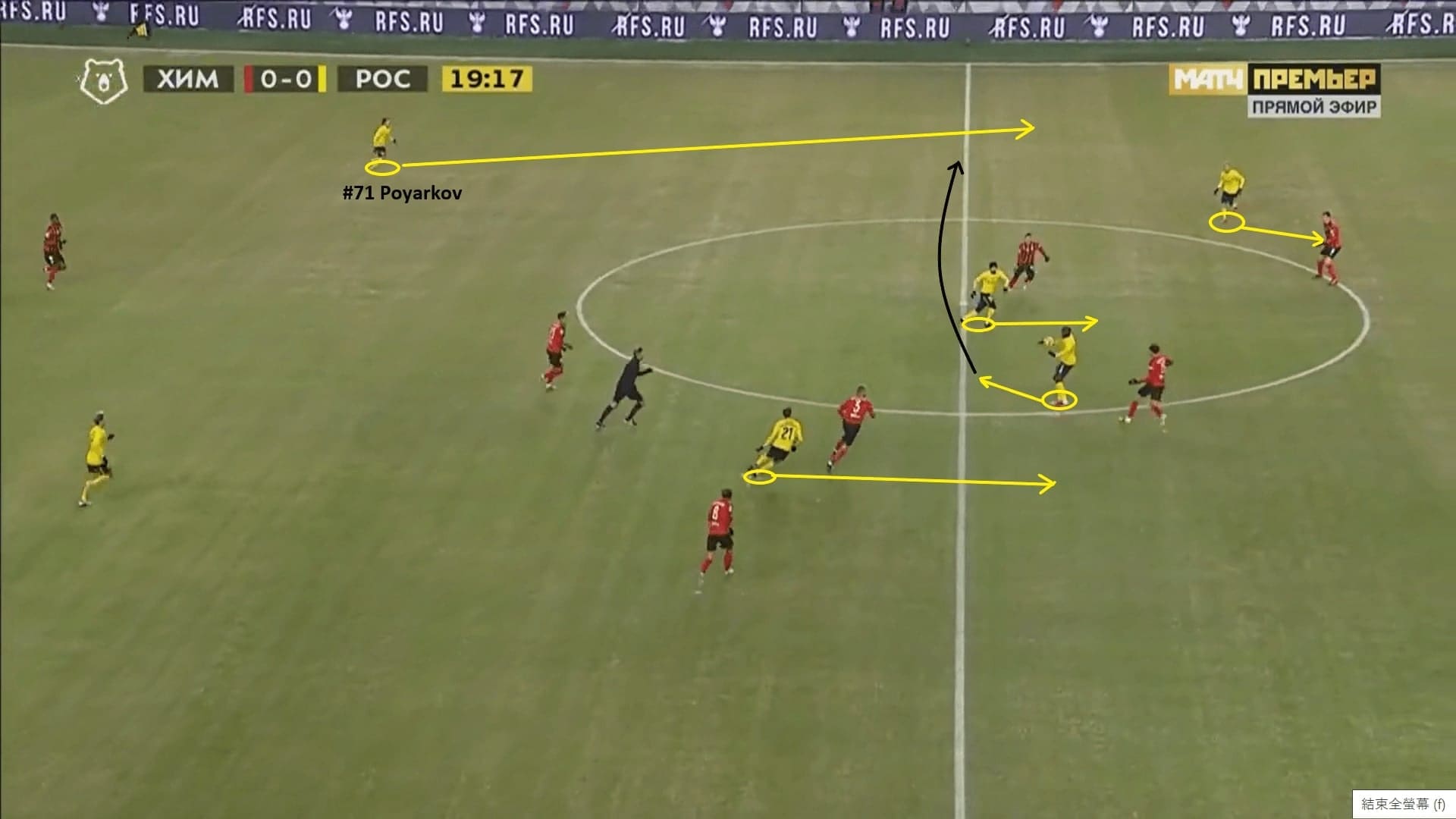
Against teams that press high or with more numbers, Karpin wants his team to bypass the block through direct passes into the space behind the opposition midfield. They recruited Sowe from CSKA Sofia to improve the effectiveness of these attacks. The 26-year-old is a good signing as he offers physical quality, off the ball runs, and serves as a target man to turn and release teammates around him after receiving direct passes from the back.
Rostov thus have a solution to play through pressure – they go long and find Sowe as a focal point directly. The striker will chest the ball down, looking for third-man runs from teammates who can then continue the attack. On some occasions, Sowe delays for a while to wait for support, with teammates making runs beyond the opposition’s defensive line to provide depth.
The above image shows these elements. Sowe controls the ball in the centre circle, with teammates running off him. Rostov’s initial overload at the centre has drawn the defence into a narrow position, leaving the wide spaces open for the full-backs. Hence, the left-back, Nikolay Poyarkov has dashed into the available space outside to be the wide third-man. Sowe’s job was to release the runners and then attack the box himself.
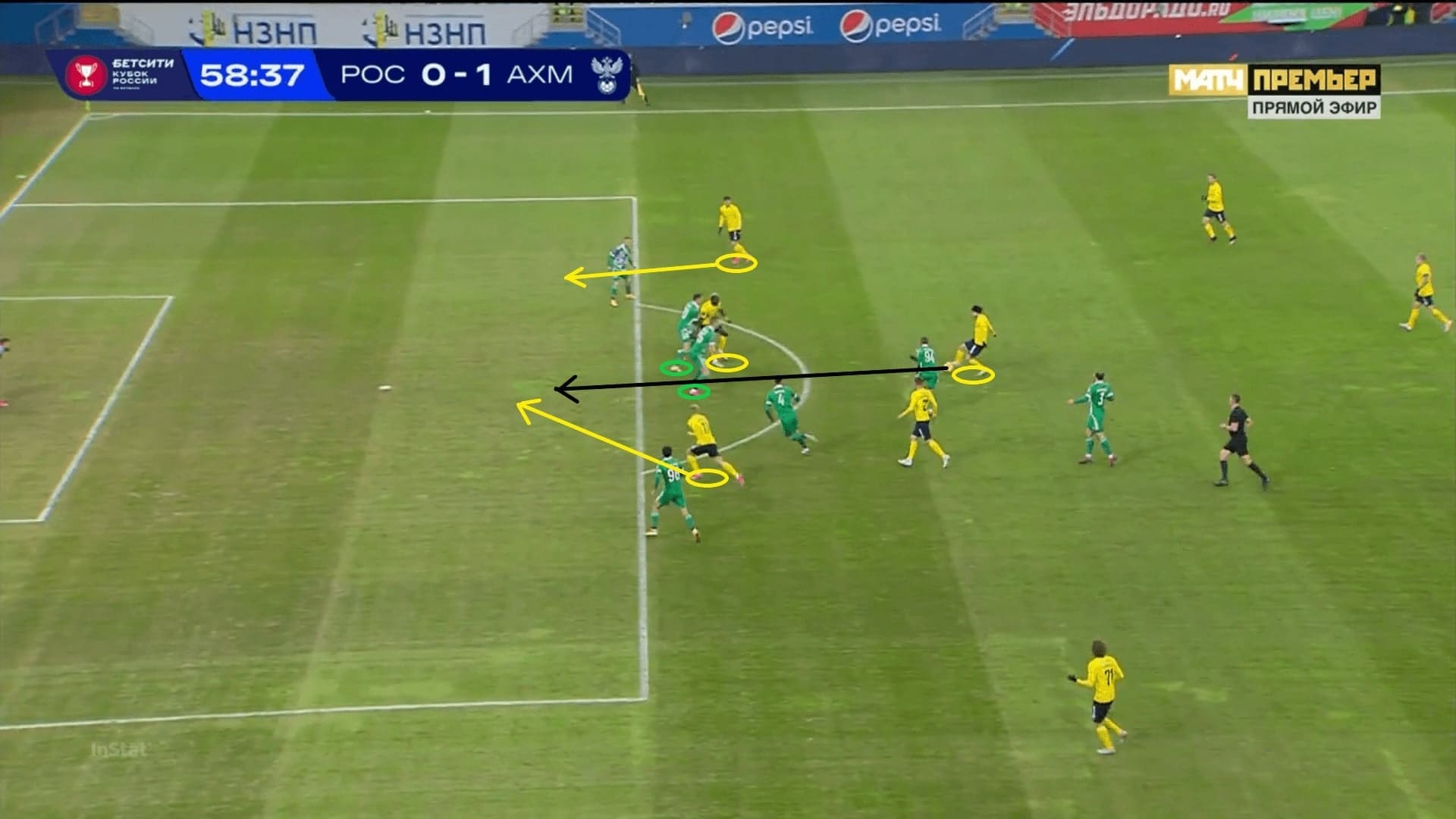
The Rostov striker will often not be the man stretching the opposition backline in the final third. Instead, he will drop off slightly to try pulling the centre-backs out, opening the channels for the wingers to run into, and therefore, searching for offensive depth is an important task for the wingers in this system. This could create clear-cut chances against the goalkeeper if a through pass was made successfully to feed these runs.
The above image shows how Sowe drops deep, which has dragged both centre-backs out of position. Hence, the opposition’s defensive structure was broken and a passing channel was opened to the left-winger, who made a diagonal run inside and behind the centre-backs. Unfortunately, Almqvist was unable to convert the chance, but this is a great example of the sort of clear-cut opportunity that can be created through this tactic.
Another strategy is to attack with crosses from out wide. With a pair of wide full-backs and numbers inside the penalty box, they can cross from any part of the pitch.
Midblock, midfield press, and traps
The PPDA (passed allowed per defensive action) for Rostov is 8.7 this season, which is the second-lowest in the Russian league. This suggests that Karpin’s team is aggressive off the ball, pressing a lot with intensity in the opposition half.
Instead of committing every player high and only defending in the opposition half, Rostov’s press is more strategic. Their engagement line is not high, it is usually at the edge of the offensive third, but the way they press is very interesting.
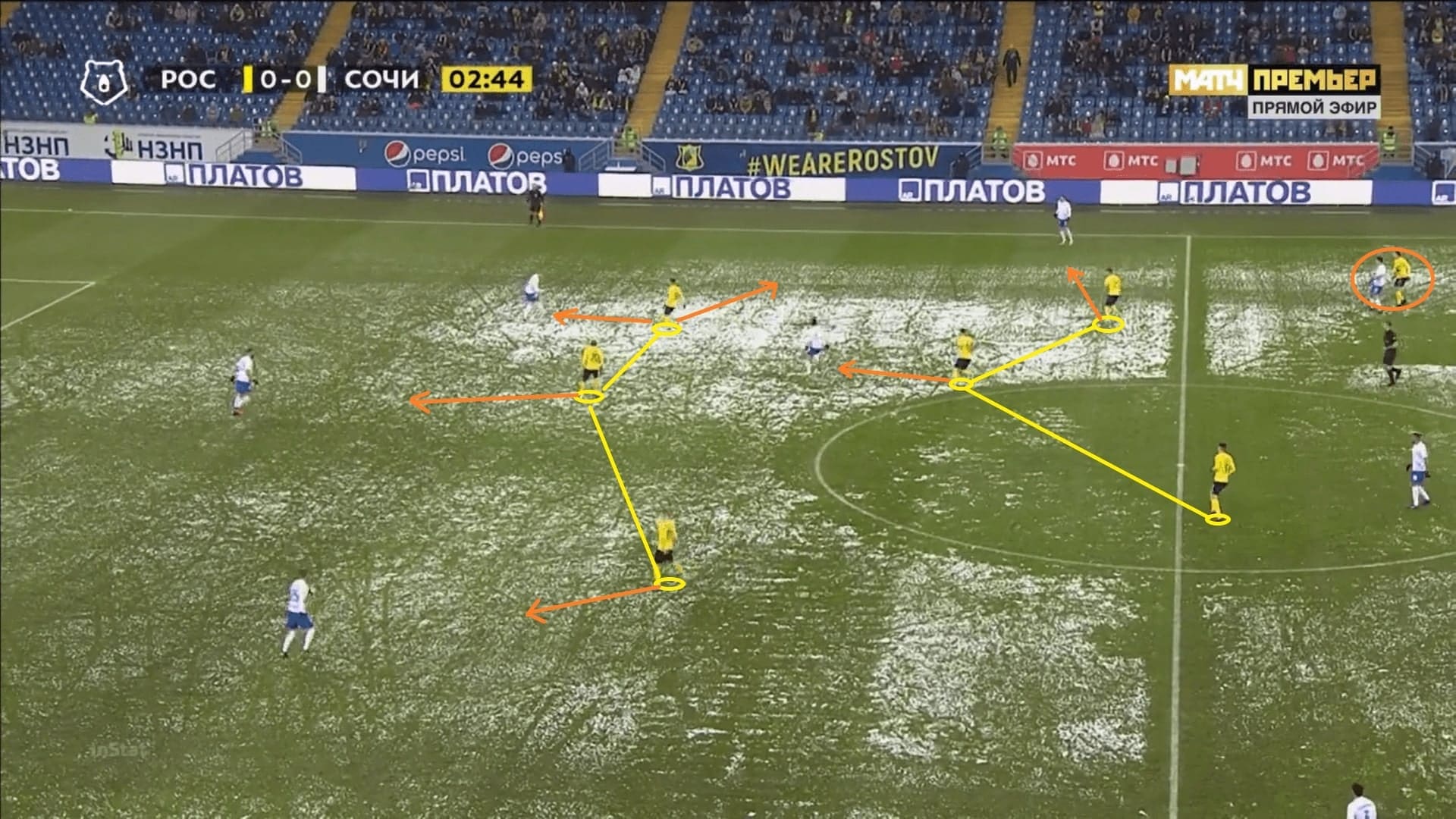
Karpin prefers his team to press in midfield, where they can control the distance between their defensive lines much more easily. Initially, they form a 4-3-3 midblock that tries to overload the central areas, forcing opponents to go outside and wide.
This image shows this 4-3-3 shape, which can be considered as a 4-2-1-3 if we understand the dynamics in their midfield. The main objective is to match the back three with the front three, creating numerical equality and also shutting off vertical passing lanes . Meanwhile, when the striker is pressing the opposition centre-back, the defensive midfielder must also step up to track the opposition pivot. Karpin usually does not want the opposition holding midfielder to have an impact on the game, and so specific strategies are employed to shut this player down wherever possible.
The wide midfielders initially protect the channels and half-spaces, but they also need to be prepared to press the full-back/wing-back whenever the ball moves out wide. The Rostov full-backs must be aware of the opposition winger dropping off, and the team can often create numerical superiority in the wider areas while defending to try and win the ball back.
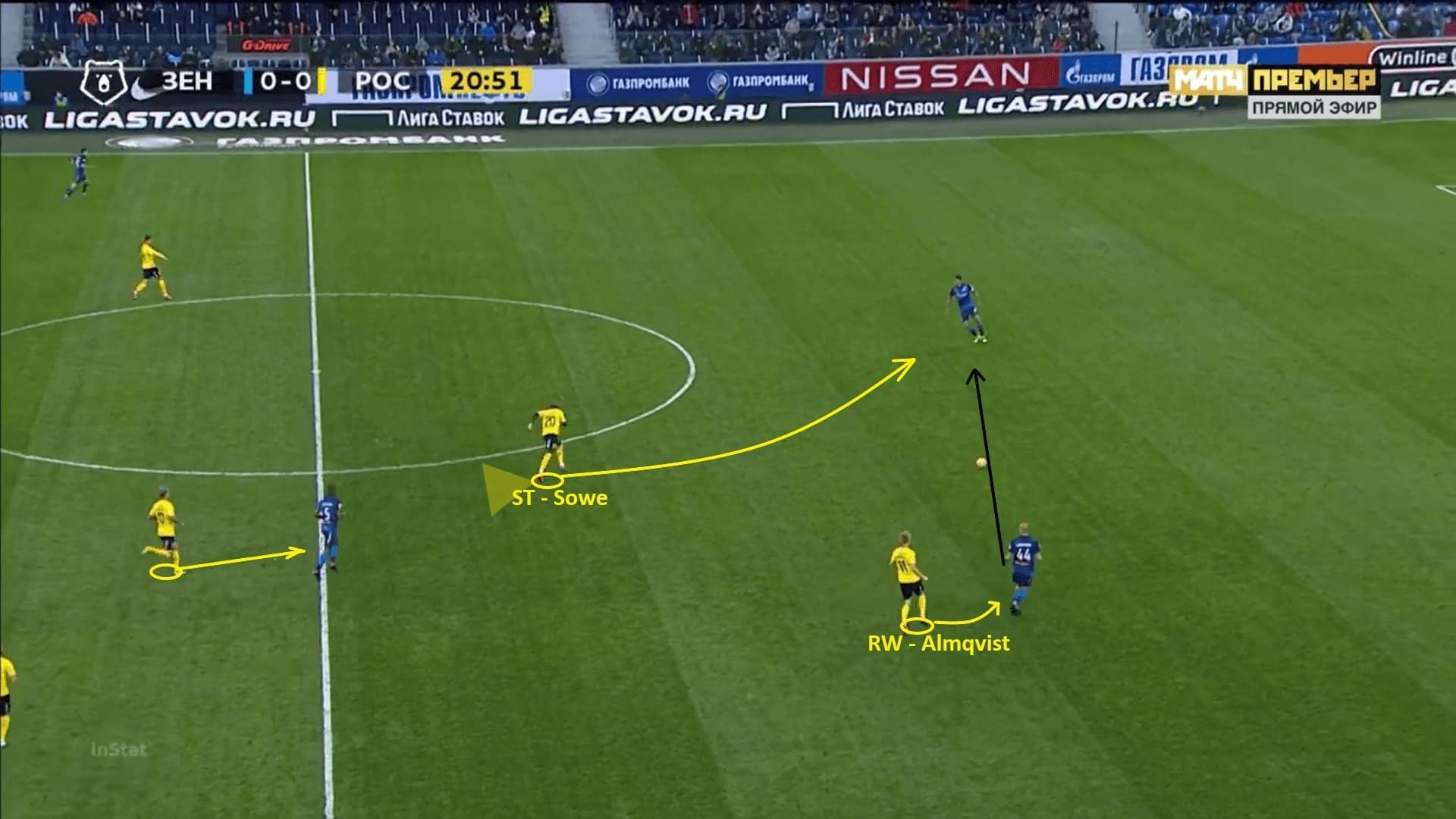
The press is not always initiated by the striker, it is more often the wingers who start Rostov’s pressure. Their pressing triggers are usually backward passes or lateral passes, with the ball-near winger starting his run to pressure the opposition.
They press in multiple ways, including using curved runs to guide the ball from one vertical half of the pitch to the other. For example, here Almqvist initiates the press, and while he pressures the centre-back, the striker spearheads the second pressing wave when the ball is passed across the pitch.
Both players shadowed Rostov’s left-sided centre-back to prevent the ball from returning to this vertical half of the pitch. Meanwhile, their midfielders can read the direction of the play early, and hence can adjust their positions to create superiorities later.
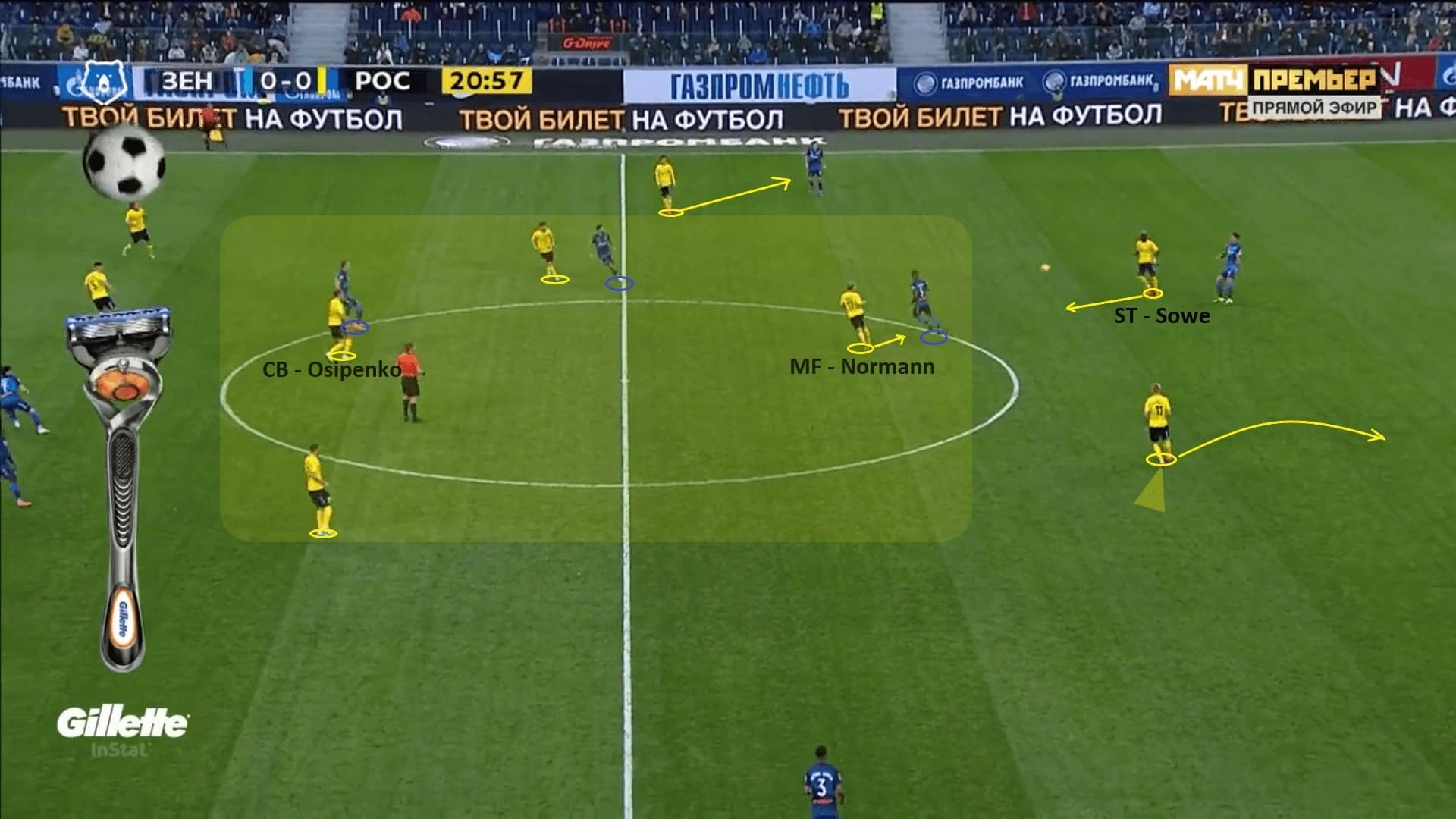
This image shows the situation after the initial press from Sowe and Almqvist. They were able to force the defence into playing the ball quickly here. As explained in the above analysis, the midfielders already saw the direction of the play in advance and moved to the corresponding vertical zones to create a numerical overload. Here, they had a 4v3 in the centre, having one more player in the highlighted yellow zone than their opponents
Therefore, when the Zenit centre-back passed the ball into the yellow zone, the Rostov players could compress space quickly to regain possession.
Another fundamental part of Karpin’s defensive system is the support provided by each player in the same vertical zone. The striker, defensive midfielder and centre-back must help each other during the press. This means that when the striker moves up to press, the pivot needs to step up as well to keep the same distance between the Rostov lines. Similarly, since the pivot stepped up, space opens up behind the Rostov midfield, so the centre-back needs to push higher to close these spaces. Opponents should only be able to pass wide, not centrally, and this relationship between the players in these three positions is essential to ensure that the team can stay vertically compact.
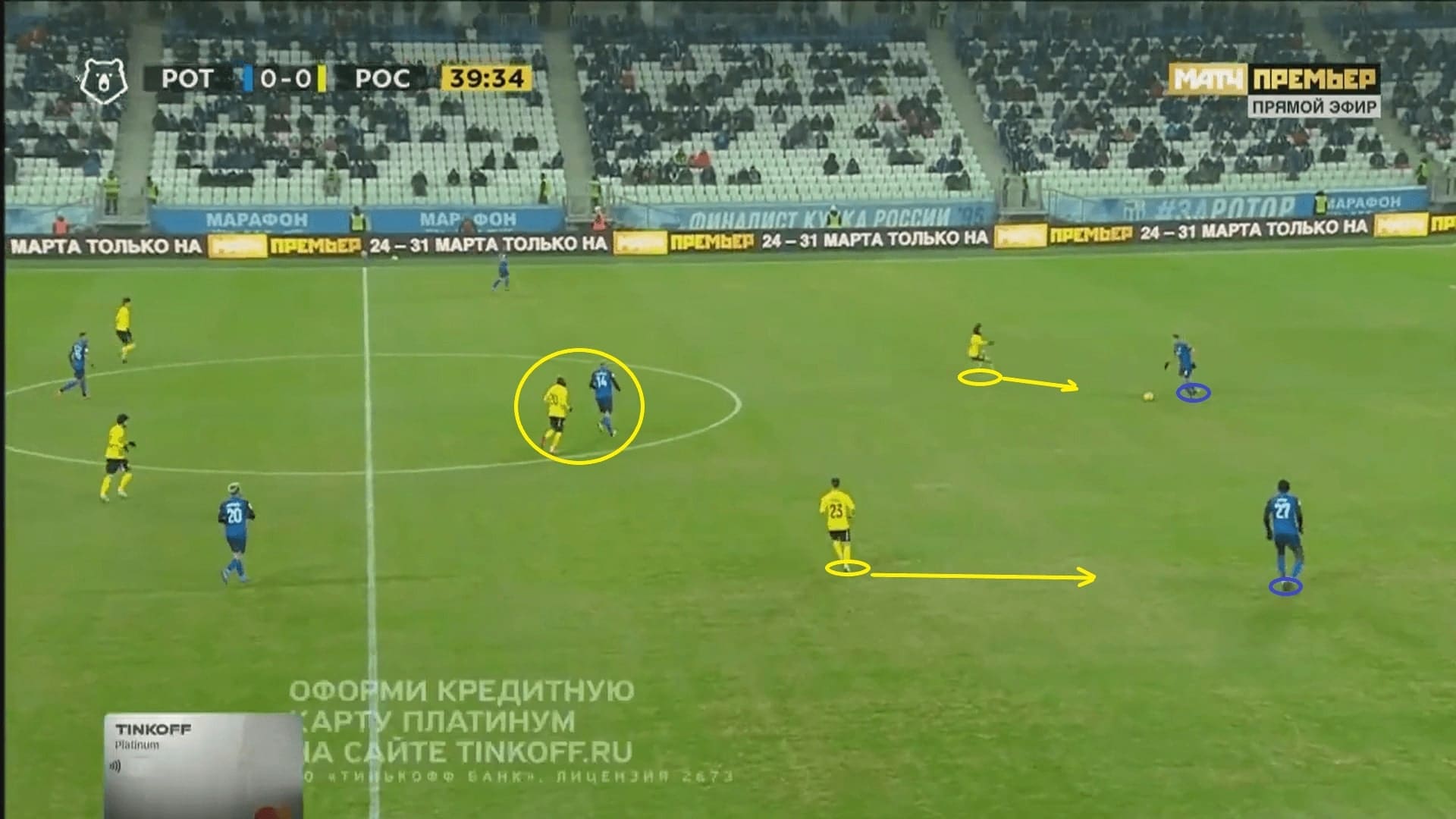
Some teams which play with a back four only played with one defensive midfielder in a 2-1 build-up shape. In these situations, the Rostov striker would stick tight to the opposition pivot to nullify the numerical superiority in the centre. Meanwhile, the wingers were tasked with pressing the centre-backs, either vertically or by curving their runs.
This was the case against Rotor recently, as shown in the image above, where both wingers were pressing the centre-backs, forcing them to move the ball quickly. Sowe was shadowing the single pivot, so this option was contained, and the opposition would have to go wide.
By keeping the pressure up at all times centrally, Rostov force the opposition wide or guide them into pressing traps, which we will explain next.
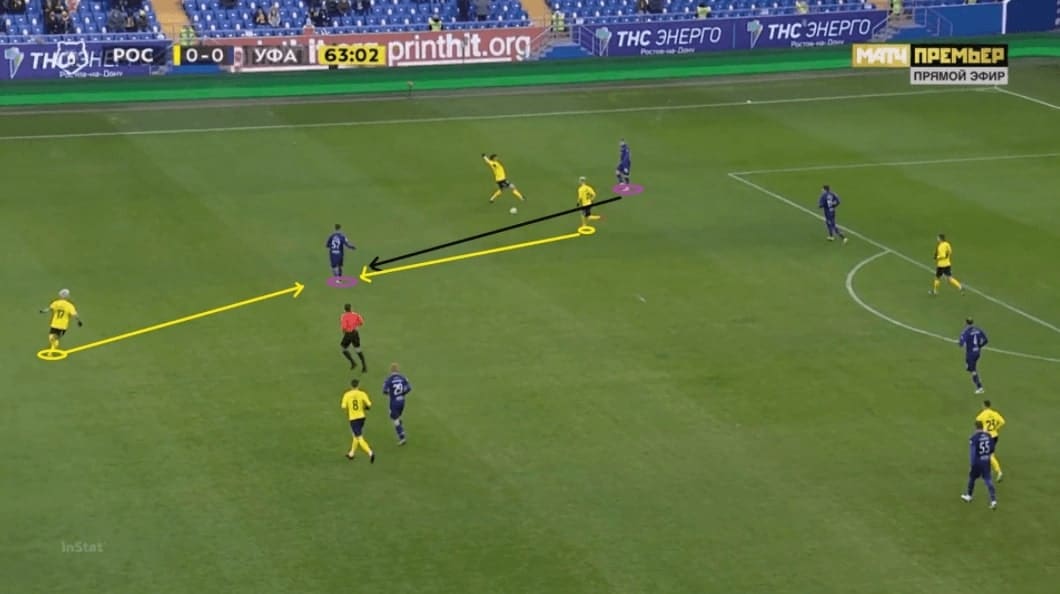
In addition to this pressing strategy, Karpin has also developed some specific pressing traps. At times, the Rostov defensive midfielder will not mark the opposition pivot tightly, creating a situation where the centre-back would feel that he is open to receive a pass. However, Normann is extremely good at pressing from the blind side, and this would therefore be a trap to regain possession centrally and high up the pitch.
This image shows Normann (#17) seemingly being late to pressure the opposition midfielder, but this was a trap. Once the pass was made, it triggered the Rostov players to press the receiver with intensity. Apart from Normann from the blindside, the player in front would also come back to double-press the receiver, making sure that there were two angles to the press. It is difficult for the receiver to escape as he is also constrained by his own closed body shape when dropping to receive the pass.
Rostov have used this trap sporadically, depending on the quality of the opposition pivot, where weaker players in possession would be targeted through this strategy. Another example of a pressing trap has been seen earlier where we saw Rostov creating numerical superiority in the centre.
Transition phases
The last section of our analysis briefly introduces Karpin’s tactical concepts during transition. Rostov are not a very aggressive counter-attacking team, but the arrival of Sowe has improved their offensive transition, increasing the possibility of converting these situations into counter-attacks.
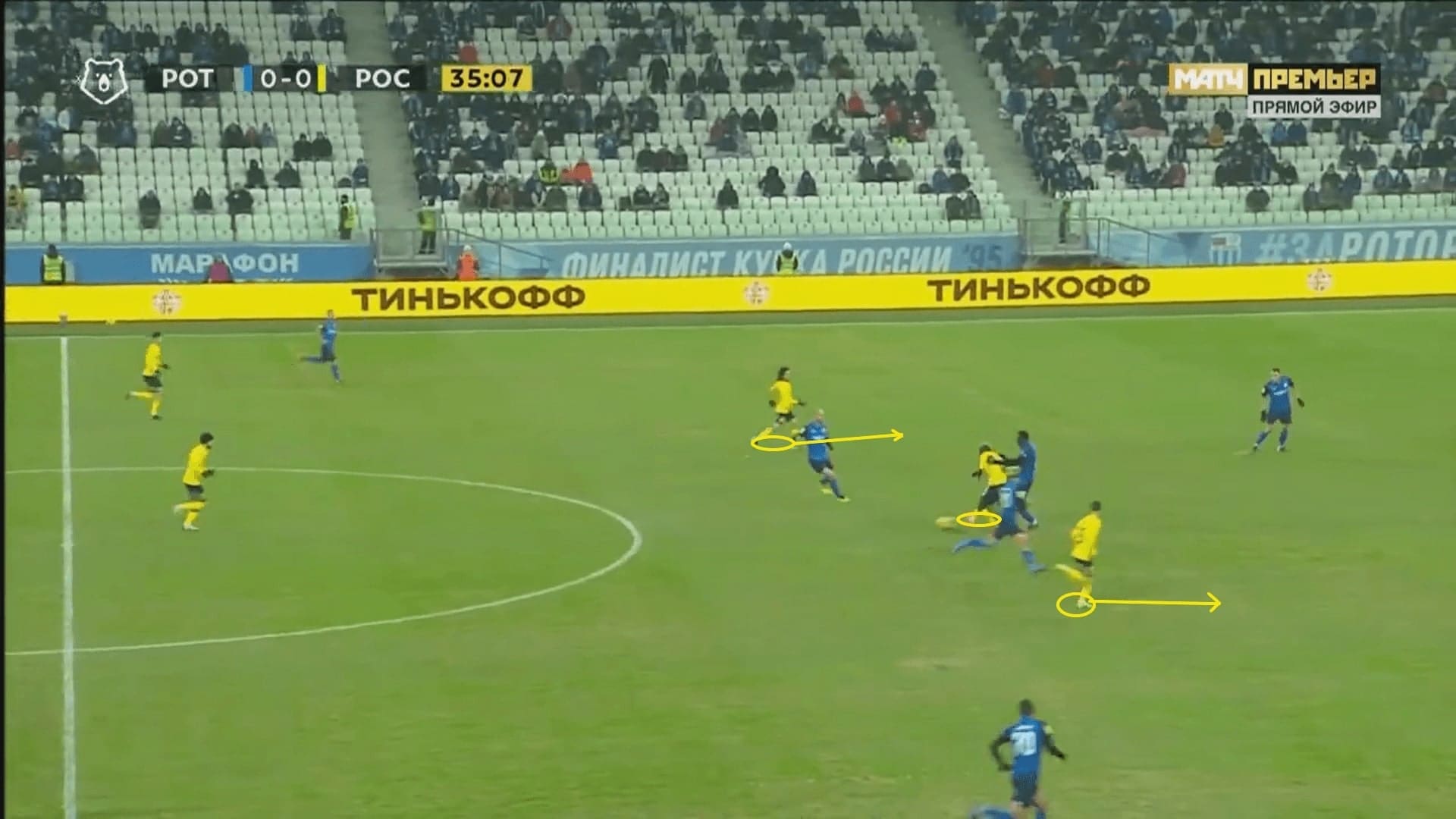
They rely a lot on Sowe’s physical strength to hold the ball up and allow the wingers and other teammates to make forward runs. This image shows how Sowe was resisting the pressure from behind and then turned to find the runners around him.
Without passing options around him, the striker will need to do everything himself – hold the ball up, turn, dribble and attack the backline. This is not an easy job, and therefore playing as a striker is a demanding role under Karpin. He has tactical duties to carry out in most phases of play and will often have to sacrifice his own goalscoring for the greater good of the team.
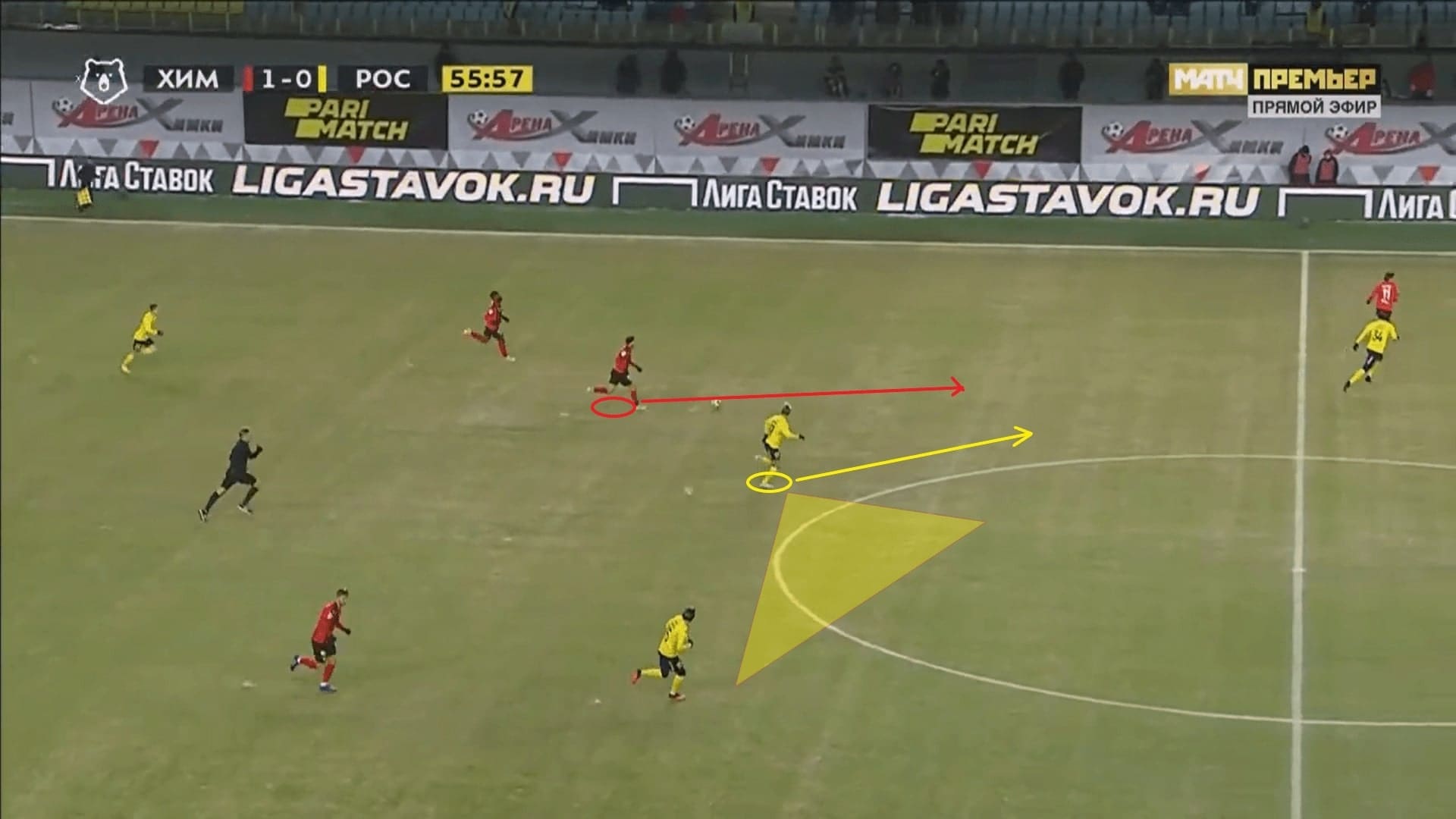
In defensive transitions, Karpin’s team try to delay and contain. They do counter-press on numerous occasions, but the concept we would like to highlight is the discipline and defensive awareness of the defensive midfielders in this system.
Normann, who is the key in this phase, must be patient to deal with counter-attacks. Despite being a good tackler and able to win the ball back in challenges, he does not stick his legs out unnecessarily. Instead, his role is to delay the opposition, forcing opponents to slow down and leave the centre so his team can recover to defend with numbers and structure. In this example, even though the Khimki player was dribbling and Normann could potentially tackle him, the Norwegian international does not do so. He protects the spaces in the centre (highlighted in yellow), controls his pace well and blocks the dribbler’s path inside, forcing him wide.
Normann is also a master of making tactical fouls to stop the opposition when needed.
Final remarks
Rostov are not in their best form since February, and they have suffered from injuries and suspensions to key players such as Hadžikadunić and Normann while at times the left-back, Haitam Aleesami, has been forced to play at centre-back in some games due to absences.
Karpin’s team currently sit in seventh place on the table, where the gap to a European place for next season is just three points. There are still plenty of games to play, and they should be able to fulfil their objective of European football for next season if key players are able to return quickly.





Comments